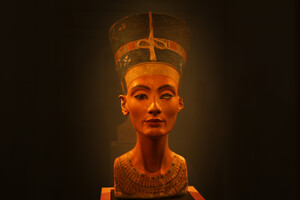Scientists have discovered new evidence in favor of this theory.

Scientists discovered hidden hieroglyphs in the tomb of Tutankhamun, which became a confirmation of the theory that Nefertiti's tomb may be nearby. According to researchers, she may be in a secret room adjacent to the tomb of the queen's stepson, reports The Guardian.
According to Nicholas Reeves, former curator of Egyptian antiquities at the British Museum, a series of radar scans failed to prove the theory. But it gained new momentum after this data appeared.
Also read: Archaeologists find earliest evidence of surgical amputation
Reeves believes that the cartouches depicting Tutankhamun's burial by his successor Ay were painted over cartouches depicting the burial of Nefertiti by the pharaoh.
“I can now claim that beneath the Aya cartouches are those of Tutankhamun himself, proving that this scene originally depicted Tutankhamun burying his predecessor, Nefertiti. Such decoration should not be in Tutankhamun's tomb,” said Reeves.
The cartouches located on the north wall depict Aya holding a ritual adze and performing the ritual of “opening the lips” of the mummy, which allowed “to return the deceased five senses”. Reeves claims that a close examination of the Aya cartouches reveals the name of Tutankhamun “who performs a ritual for the tomb's original owner, his predecessor Nefertiti.”
“This conclusion finds absolute confirmation in the profiles of the depicted individuals—the snub nose and plump chin of [the man] currently identified as Ai is combined with… the precisely standardized facial outline adopted for official depictions of Tutankhamun at the very beginning of his reign. The face of the mummy contains the unmistakable features of Nefertiti. The scene apparently began life as a depiction of Tutankhamun officiating at his predecessor's funeral,” Reeves added.
Tutankhamun's tomb was discovered more than a hundred years ago by Howard Carter. It was filled with thrones and chariots that the boy pharaoh would need in the afterlife.
But Reeves notes that Tutankhamun's sudden death at the age of just 19, after nine years in power, must have meant that his hid in a hurry. According to him, the tomb was opened 10 years after its construction, its external elements were removed and prepared for the burial of the “cuckoo prince”.
The scientist believes that the new discovery confirms that Tutankhamun's tomb is only part of a larger burial “prepared for Nefertiti and still by her”. The queen's burial chambers still remain hidden from scientists.
In 2015, Reeves stated that high-resolution images of Tutankhamun's tomb showed lines beneath the plastered surfaces of the painted walls, indicating unexplored doorways. Other experts note that the scan has not yielded any definitive results.
“It is very easy to write it off as pure fantasy, but… I found that the wall decoration in the burial chamber had been changed. Tutankhamun's tomb has always puzzled us because of its strange shape. She is very small and not the kind that a king should have,” Reeves said. to turn out to be the mummy of Queen Nefertiti. The historian of Ancient Egypt, who in the past held the position of secretary general of the Supreme Council of Antiquities of the country, is preparing the exhibition “Daughters of the Nile”, dedicated to the women of Egypt during the reign of the pharaohs.




